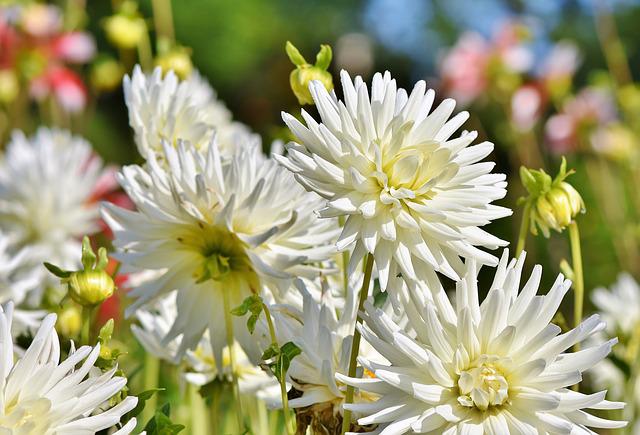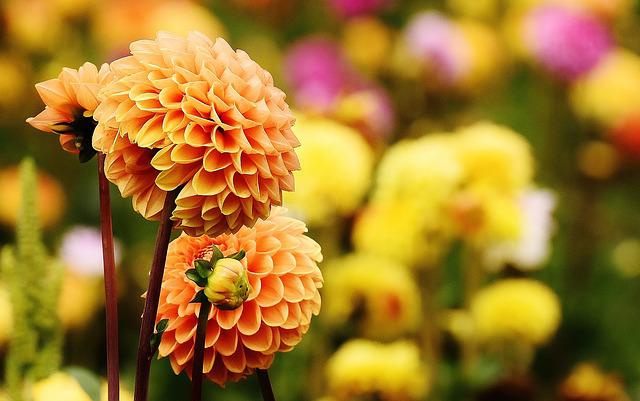Do Dahlias Bloom All Summer? | 5 Tips For More and Longer Blooms

Most dahlia flowers will bloom all summer long if you live in a warm climate. However, if you enjoy cooler weather enjoyed by many northern friends, your dahlias may only flower for part of the summer. The key to enjoying both types of summers is to plant varieties adapted to your local climate and monitor their growth! Carefully maintaining your dahlias by regularly deadheading them throughout the summer will ensure continuous flowering until the first frost kills the plant.
If you enjoy a long summer bloom season, there are some things you can do to help your Dahlias reach their full potential. Check out here!
Table of Contents
5 Tips for Longer and Increasing the Number of Blooms on Your Dahlias
1. Deadheading
In the garden, dahlias take center stage in July. Their large, vibrant blossoms are a welcome addition to the flower bed. Merely deadheading the flowering stems can maintain this vibrant hue. As long as you deadhead them regularly, dahlias will bloom from July until the first frost, which typically occurs in October or November. The first frost kills dahlias, so their blooming season is over for another year.
Dahlia flowers are pretty, but they only last a short time. When the flower has died, use sharp pruners to cut off the flower stem just above where it comes out of the stem. When deadheading, don’t leave a stump behind. Taking off the spent flowers regularly encourages the plant to make more blooms and stops it from making seeds, which takes a lot of energy from the plant and reduces the number of future blooms.
2. Maintain the Plants’ Upright Position
The blooms of dahlias are easily ruined if the plants are allowed to lie on the ground. Utilize a 1-inch-by-1-inch hardwood stake to maintain straight and upright stems. To affix the plant’s branches to the stake, you’ll require some sturdy jute twine. Due to the rapid growth rate of dahlia plants, check their stems once per week to determine if they need to be tied higher up. Consider using a sturdy tomato cage to maintain the upright position of large dahlia varieties with numerous branches. In this case, the tomato cage must be placed over the plant when it is only a few inches tall. If you wait too long to install the cage, you must wrestle the plant into it.
3. Fertilize
Every two weeks, I feed my dahlias an organic liquid fertilizer. Both the roots and the leaves can take in liquid fertilizers, so don’t be afraid to put some on the leaves as well as soak the soil. Liquid organic fertilizer that is a little bit higher in phosphorous helps plants make more flowers and keeps their stems from getting weak and spindly.
4. Be Vigilant for Fungal Diseases
While dahlias are generally trouble-free, fungal problems can occasionally arise. Bud blast will cause flower buds to collapse and rot before they open, and leaf spots and other foliar diseases can easily damage the foliage. To prevent these problems:
- Give your dahlia plants ample space to grow and keep other plants from crowding around them.
- Reduce nearby foliage to improve airflow around the plants.
- If you discover diseased foliage on your dahlias, remove it immediately and dispose of it in the trash.
5. Irrigate
Larger dahlias can get quite tall and thirsty as they develop. Water your dahlia plants frequently, especially if there is a drought. To help the soil retain moisture, mulch the plants with a few inches of compost, leaf mold, or chopped-up leaves. Instead of giving the plants a quick spritz of water every day or two, water them deeply and thoroughly once a week. Deep irrigation promotes deeper roots and is more capable of accessing moisture and nutrients.

Deadheading For More Blooms
Dahlia (Dahlia spp.) flowers offer consistent splashes of color throughout the warm summer months. From midsummer to autumn, each plant produces a succession of flowering flushes. Dahlias thrive in USDA plant hardiness zones 7 through 10, where severe frost is uncommon. The flowers produce seeds once they begin to wilt, which diminishes the beauty of the plant and may shorten its blooming season. Eliminating the spent flowers, also known as deadheading, ensures a healthy, continuous bloom.
- Check the dahlias for dead or dying flowers at least once per week. Remove flowers as they wilt and any blooms that have completely wilted and are beginning to form seed pods.
- Hold the stem just below the flower head, about a quarter of an inch above the highest leaves, with your thumb and forefinger. Remove the flower head entirely by pinching off the stem. Or, you can use sharp shears to sever the stem here.
- Remove any diseased or wilted leaves you find while deadheading. The dahlias stay tidy and presentable thanks to regular leaf removal.
- After each trimming, remove the spent flowers and throw away the trimmed foliage. Pests and diseases can thrive in decaying plant matter.
